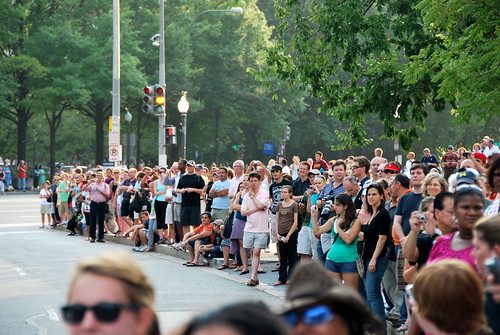From Fortune, based on data from the 2010 Census: DC has more single-occupant households than any other major US city. DC’s 48% of households is even higher than Manhattan’s 46%.
Are you the 48%?
From Fortune, based on data from the 2010 Census: DC has more single-occupant households than any other major US city. DC’s 48% of households is even higher than Manhattan’s 46%.
Are you the 48%?

‘The working escalator’
courtesy of ‘ianseanlivingston’
It’s no surprise that there’s a correlation between rates of people driving to work and higher rates of obesity, but GOOD has created a fun new graphic that shows it in an interesting way. This map of the US shows rates of walking, biking, and taking transit to work alongside obesity rates. Since DC is compared to more spread out states, we obviously come in first place in the walking/biking/transit commute rates, and we’re third lowest (behind super-active Colorado and Connecticut) in statewide obesity rates.
The typical caveat applies here: when DC is compared to states the results should be taken with a grain of salt. Virtually any dense city would beat out statewide averages in terms of rates of taking non-motorized transportation to work. And we shouldn’t pat ourselves on the back too much– there’s still a lot of work to be done to reduce obesity in DC. While overall the District may be considered healthy and active, the obesity rates in Wards 7 and 8 are nearly double the District average (and much worse than the national average).
But still, next time you’re stuck walking up a broken Metro escalator, remind yourself that it’s keeping you fit!

‘274/365 Filling out the census’
courtesy of ‘eiratansey’
I love busting myths about the city in this feature, but myths about owning vs. renting, the international nature of DC’s residents, and how no one is from DC would be impossible to bust without cold hard data. And where do we get that data? The Census! And now is an exciting time– Census forms should be arriving this week, and now you get to do your civic duty and fill out your form.
There are a lot of myths about the Census– who should fill it out, what the information can be used for, etc– and this is the first time that many of us are the heads of households filling out these forms. Lucky for us, we’ve got Maurice Henderson, the director of DC Counts, to help us bust this week’s Census-related myths. Check out what Maurice had to say about three big myths Census myths.

”
courtesy of ‘flipperman75’
Now that the snow is melting and the city is returning to normal, let’s focus on a non-snow topic for a change. Last Friday’s commute from hell showed us all that the city’s transportation network wasn’t quite ready for the influx of commuters going to work. That got me thinking– how many people commute into DC, and how does that compare with other cities? And does the population of the District really double during the day?
Once again, the Census provides all these answers– so keep in mind this data is almost a decade old, but until we fill out and return our Census forms this spring, it’s the best we can do. The Census tells us that in 2000, 572,059 people lived in the District (and because DC is such an awesome city, more people are moving here– the population was estimated at 588,373 in 2008). On top of that, over 400,000 more people commute into the District from Maryland, Virginia, West Virginia, and Pennsylvania on any given weekday. That leaves DC’s daytime population in 2000 at 982,853– 172% of its nighttime population.

‘Flagged entry’
courtesy of ‘afagen’
Hi, and welcome to a new year of Mythbusting! We’re going to start out the year off with a myth about the character of the District. When I first moved to DC, I always thought it was such an international city– walking down the street, you hear people speaking foreign languages, and with all the embassies it seemed like it was home to people from many different nations. And I’m not alone– there are clubs in the city focused on bringing international professionals together, and DC is known as a major global city. But is the District home to more people from foreign countries, and more foreign speaker, than other peer cities?

‘moving boxes’
courtesy of ‘ilya’
Welcome to another edition of DC Mythbusting. This week we’ll tackle the myth that no one is really from DC. The District has a reputation as a transient city, with young go-getters coming here after college, putting in a few years on the Hill, then moving on to bigger and better things. But is DC really more transient than other similar cities? Is no one really from DC?
The answer is no, but there’s a bit of a qualifier to that. The best resource to answer this question would be the US Census, which asks a question about where you lived 5 years ago compared to where you live now. But the 2000 Census is seriously outdated (especially since the demographic makeup of the District has changed significantly since then), and the 2010 Census hasn’t started yet. So the next best resource is the annual American Community Survey, which asks two questions that help us answer this question: where was your residence one year ago? and which state were you born in? After the break, see what the American Community Survey tells us about DC.